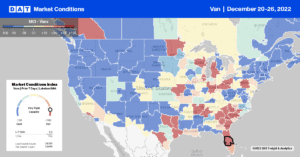As the retail shopping season nears the finish line, November import volumes confirm a non-existent peak season in the retail sector. According to IHS Markit, TEU (twenty-foot equivalent unit) import volumes were down 9% m/m in November, and unlike prior years, import volumes are slowing rapidly. Since the peak in imports in May this year (which recently resulted in overstocked warehouses), total TEU volumes have dropped 23%. Imports from Northern Asia have dropped by 26% over the same timeframe.
With most holiday merchandise already on retailers’ shelves or in their warehouses, December truckload volumes are starting to flatten out with best estimations of a flat to slightly up year-end projection. NRF Vice President for Supply Chain and Customs Policy Jonathan Gold said, “Retailers are in the middle of the annual holiday frenzy, but ports are headed into their winter lull after one of the busiest and most challenging years we’ve ever seen.”
On the West Coast, the International Longshore and Warehouse Union members have been working without a contract since their previous agreement with the Pacific Maritime Association expired on July 1. Worries about potential West Coast disruption led many retailers to bring in cargo early this spring, resulting in a shift to East Coast and Gulf Coast ports. November imports on the West Coast were down 14% y/y, down 6% y/y on the East Coast but up 2% y/y along the Gulf Coast. Houston appears to have benefited the most from the coastal shift in imports, where volumes are currently up 7% y/y following last month’s 3% m/m decline.
The Global Port Tracker forecasts December imports at 1.94 million TEU, down 7.2% y/y, followed by 1.97 million in January 2023 and 1.67 million in February.
Market Watch
All rates cited below exclude fuel surcharges unless otherwise noted.
Dry van spot rates decreased in only two lower 48 states last week as carriers took time off over the break. Linehaul rates in Montana and New Mexico were down by around 4% last week, while the remaining 46 states increased by the same amount. In the significant freight-producing states of California, Texas, Illinois, Georgia, Pennsylvania, and New Jersey, spot rates increased by $0.17/mile to an average of $2.21/mile, excluding fuel (the third-highest in the last seven years. These states averaged $3.05/mile for outbound loads compared to the previous year.
In the Pacific Northwest, available capacity was tight in Seattle, pushing up spot rates by $0.08/mile to a market average of $1.57/mile. Loads on high-volume lanes, including Stockton, 800 miles to the south, surged to an average of $1.49/mile. However, this rate is still almost $1.00/mile lower than the previous year when flooding rain ravaged the region and closed down major intermodal routes. In the combined Los Angeles and Ontario markets, spot rates were up for the fourth week, increasing by $0.08/mile to an outbound average of $2.01/mile. The Los Angeles to Stockton lane was paying carriers $2.96/mile last week, up $0.37/mile compared to the November average but a whopping $1.62/mile lower than the previous year at the peak of port congestion and imports in the San Pedro Bay Port Complex.

Load-to-Truck Ratio (LTR)
Even though last week was a short work week for most, load posts were up by 4% w/w following a similar trend to the prior two years. Volumes ended the year down by almost 40% compared to the previous year but still at the second-highest level in the past six years. Carrier equipment posts remained at the highest level in six years and 13% higher than last year. As a result, last week’s dry van load-to-truck ratio (LTR) increased by 50% w/w from 3.71 to 5.57.
Linehaul Spot Rates
The national average dry van rate ended 2022 at just over $2.00/mile, which was $0.75/mile lower than where rates started the year. Spot rates increased by $0.10/mile for the second week in succession to an average of $2.02/mile. Compared to pre-pandemic years, last week’s national average was $0.23/mile higher for the final shipping week of the year. The national average linehaul rate of $2.02/mile was $0.27/mile lower than the top 50 dry van lanes based on the volume of loads moved, which averaged $2.29/mile last week.


